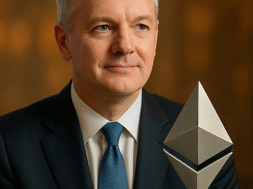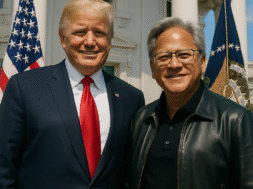
Ethereum at 10: How a Coding Dream Became Wall Street’s Secret Engine
CANNES — A decade ago, Vitalik Buterin and a handful of developers gathered in a chilly loft in Berlin, surrounded by bare bulbs, battered chairs, and scattered laptops. They weren’t executives or backed by billion-dollar funds — just passionate visionaries chasing a bold idea late into the night.
From this modest workspace, Ethereum’s first version, Frontier, came to life. It had no slick design or interface — just raw functionality: mining, executing smart contracts, and enabling developers to test decentralized applications. This was the genesis of a platform that would reshape global finance.
At a time when Bitcoin was dominating headlines as “digital gold,” Buterin’s creation went further — programmable money that could enforce contracts, move funds autonomously, and power decentralized systems without the need for banks or middlemen.
Back in Zurich a year prior, IBM security flagged a “kid” walking unsupervised in their lab. But it wasn’t a child — it was Buterin, then developing Ethereum’s foundations. That early-stage code, which would go on to support a $420 billion ecosystem, caught the attention of Paul Brody, a lead researcher at the time.
“I was shown this concept — like Bitcoin, but faster and programmable,” Brody recalled. “I immediately thought, ‘This is the future. This is what we need.’” That vision led Brody to pivot entirely into blockchain and help IBM build its first prototype on Ethereum, launching it alongside Samsung at CES 2015.
Today, as global blockchain leader at EY, Brody still reflects on that turning point — and admits feeling a tinge of envy for Buterin’s early head start. “He was young, but none of that mattered. He was changing the game.”
From Cypherpunk Havens to Red Carpets
Ethereum’s journey from underground hacker circles to financial institutions began in places like Paralelní Polis in Prague — an anarchist tech hub rooted in Václav Benda’s “parallel society” philosophy. There, Buterin emphasized Ethereum’s true power: helping individuals in countries with broken financial systems connect to the global economy.
Back then, crypto was a resistance movement — prioritizing privacy, resilience, and autonomy. Fast forward to today, and Ethereum’s flagship conferences take place in glamorous venues once reserved for Hollywood icons — symbolic of how far the technology has come.
The New Financial Backbone
Brody likens today’s financial system to a maze of pipes. Now, Ethereum is being woven into those pipelines. Where crypto once operated on separate rails, Ethereum is becoming part of the infrastructure itself — settling stablecoins, tokenized assets, and real-time transactions for institutions and individuals alike.
Digital dollar equivalents — known as stablecoins — now power trillions in payments, much of which flows through Ethereum. Robinhood recently introduced tokenized U.S. stocks on an Ethereum-based network, while Circle’s USDC — the second-largest stablecoin — sees about 65% of its volume settled on Ethereum.
Last year alone, stablecoin activity surpassed $28 trillion — eclipsing Mastercard and Visa combined. Major banks are responding: one top European bank announced a tokenization platform built on Ethereum’s layer-two scaling tech, optimized for regulatory compliance and secure asset management.
Exchanges like Coinbase and Kraken are also embracing this crossover, rolling out tokenized equities and prediction markets. Even asset giants like BlackRock have moved, launching tokenized money market funds offering real-time redemptions in stablecoins.
Despite newer blockchains promising speed and low fees, Ethereum remains the most trusted network. Its reliability and uptime make it the preferred choice for institutions.
Buterin emphasized that it’s not just about transaction speed — it’s about stability, programmability, and global reach. Institutions, he said, value Ethereum because it works consistently and supports the features they care most about: privacy, decentralization, and censorship resistance.
The Institutional Standard
From Deutsche Bank to Coinbase, from Robinhood to Kraken — everyone is building on Ethereum’s base or layer-two infrastructure. Tomasz Stańczak, now a co-executive director at the Ethereum Foundation, says it’s because Ethereum has upheld its principles for ten solid years.
“When institutions send an order, they want fairness, transparency, and timing certainty — Ethereum guarantees that,” he said.
That trust matters more than ever as financial markets digitize.
Scaling Without Selling Out
Ethereum’s path has been turbulent. It endured price bubbles, stiff competition, and accusations of being too slow or costly. But it endured — and evolved.
In 2022, Ethereum underwent a radical transformation — switching from energy-hungry proof-of-work to proof-of-stake, cutting energy usage by 99.5%. The shift paved the way for faster, more affordable applications without compromising security.
Now, the priority is completing Ethereum’s technical roadmap. That means improving transaction speeds, enhancing decentralization, and protecting against future threats — all while making it accessible on devices as small as smartwatches.
Zero-knowledge proofs and algorithmic upgrades are next, enabling even greater scalability and security. But the revolution, Buterin says, won’t be loud — it’ll grow silently in the background until it becomes the norm.
A Quiet Revolution in Motion
Wire transfers are moving on-chain. Real estate and equities are being tokenized. Contracts — legal terms, payments, product delivery — are beginning to run autonomously on blockchain rails.
Brody believes the next wave of financial products won’t just replicate legacy systems — they’ll be rebuilt from the ground up, using Ethereum as their core layer.
“We don’t just copy the old systems,” he said. “We build new ones. That’s the real impact of blockchain — enabling things we simply couldn’t do before.”
And if Ethereum continues on this trajectory, the biggest financial transformation of our time might not come with a bang — but with seamless, invisible integration into the way the world moves money.













